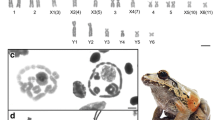Abstract
Female karyotypes from ovarian cell cultures of 20 species of killifish (Fundulus) ranged in diploid number from 32 to 48, but in arm number (NF) from 48 to 52. The “small” F chromosomes, which constituted the fundamental elements in the karyotype, were evenly graded in length. The “large” biarmed chromosomes (L), which were about twice the length of the average Fs, characterized only those species with 2N less than 48 chromosomes. And among these species, an increase in complement by a pair of L's was always accompanied by a decrease of two pairs of A's, indicating Robertsonian changes by the centric fusion of two A's to form one L chromosome. Other diagnostic chromosome characters included: the number and structure of biarmed and satellited F chromosomes and the percentage of F's with relatively short short-arms (SSA). Besides centric fusion, mechanisms of chromosomal evolution in Fundulus probably included pericentric inversion, producing biarmed F chromosomes from acrocentric F's and partial loss of a chromosome segment producing smaller biarmed F chromosomes from larger ones. The percentage of SSA chromosomes generally decreases from relatively primitive to specialized species. The presumably most primitive species have only SSA type acrocentric F chromosomes. The 20 Fundulus species were classified into 2 major groups according to the percentage of SSA chromosomes: the SSA group, including 3 subgroups, had more than 50% SSA's; the LSA group, including 2 subgroups, had fewer than 50% SSA's. This classification based only on karyotypic characters generally agreed with others based on gross morphological characters. A possible evolutionary scheme is proposed to account for the derived killifish karyotypes.
Similar content being viewed by others
References
Brown, J. L.: A key to the species and subspecies of the cyprinodont genus Fundulus in the United States and Canada east of the continental divide. J. Wash. Acad. Sci., 1957, 69–77.
Chen, T. R.: Comparative karyology of selected deep-sea and shallow-water teleost fishes. Ph. D. thesis, Yale University (1967).
—: Fish chromosome preparation: Air-dried displays of cultured ovarian cells in two killifishes (Fundulus). J. Fish. Res. Bd. Canada 271, 158–161 (1970).
- Reisman, H. M.: A comparative chromosome study of the North American species of sticklebacks (Teleostei: Gasterosteidae). Cytogenetics (In press).
—, Ruddle, F. H.: A chromosome study of four species and a hybrid of the killifish genus Fundulus (Cyprinodontidae). Chromosoma (Berl.) 29, 255–267 (1970).
Denton, T. E., Howell, W. M.: A technique for obtaining chromosomes from the scale epithelium of teleost fishes. Copeia (Wash.) 1969, 391–392 (1969).
Farris, J. S.: The evolutionary relationships between the species of the killifish genera Fundulus and Profundulus (Teleostei: Cyprinodontidae). Ph. D thesis, University of Michigan (1968).
Hall, M. F.: A comparative study of the reproductive behavior of the stickle-backs (Gasterosteidae). Ph. D. thesis, Oxford University (1956).
Miller, R. R.: An annotated list of the American cyprinodontid fishes of the genus Fundulus, with the description of Fundulus persimilis from Yucatan. Occ. Pap. Mus. Zool. Univ. Mich. 568, 1–25 (1955).
Ohno, S.: The enormous diversity in genome sizes of fish as a reflection of nature's extensive experiments with gene duplication. Trans. Amer. Fish. Soc. 99, 120–130 (1970).
—, Atkin, N. B.: Comparative DNA values and chromosome complements of eight species of fishes. Chromosoma (Berl.) 18, 455–466 (1966).
—, Stenius, C., Faisst, E., Zenzes, M. T.: Post-zygotic chromosomal rearrangements in rainbow trout (Salmo irideus Gibbons). Cytogenetics 4, 117–129 (1965).
Relyea, K. G.: Systematic study of two species complexes of brackish water Fundulus (Pisces: Cyprinodontidae). Ph. D. thesis, Tulane University (1967).
Roberts, F. L.: A chromosome study of twenty species of Centrarchidae. J. Morph. 115, 401–417 (1964).
Setzer, P. Y.: A karyological analysis of members of the genus Fundulus. MA thesis, University of Texas, Austin (1968).
—: An analysis of a natural hybrid swarm by means of chromosome morphology. Trans. Amer. Fish. Soc. 99, 139–146 (1970).
Snedecor, G. W.: Statistical methods, 5th ed. Ames, Iowa: Iowa State College Press 1957.
Author information
Authors and Affiliations
Rights and permissions
About this article
Cite this article
Chen, T.R. A comparative chromosome study of twenty killifish species of the genus Fundulus (Teleostei: Cyprinodontidae). Chromosoma 32, 436–453 (1971). https://doi.org/10.1007/BF00285254
Received:
Accepted:
Issue Date:
DOI: https://doi.org/10.1007/BF00285254




